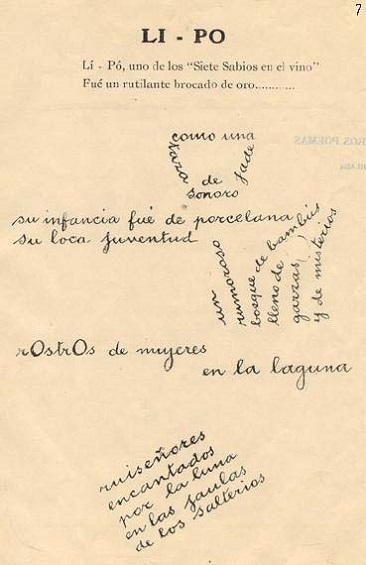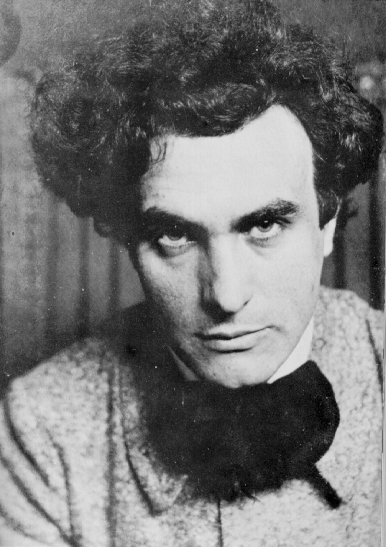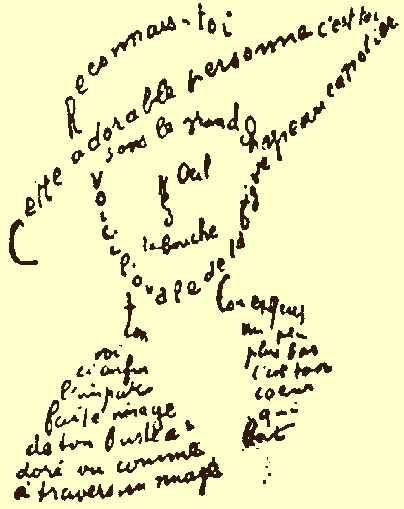|
José Juan Tablada
José Juan de Aguilar Acuña Tablada (April 3, 1871 – August 2, 1945) was a Mexican poet, art critic and, for a brief period, diplomat. A pioneer of oriental studies, and champion of Mexican art, he spent a good portion of his life living abroad. As a poet, his work spans from the fin-de-siècle style to avant-garde experimentalism. He was an influential early writer of Spanish-language haiku. Career Tablada was born in Mexico City and studied at Chapultepec Castle. He at first worked for the national railways. In 1890, aged 19, he began contributing to magazines and newspapers as a journalist, essayist and poet. In 1894 his rhythmic and intricate poem "Onix" brought him renown. ''Florilegio'', his first collection of poetry, was published in 1899 and established him as one of Mexico's pioneer 'modernists', although at that period such writing approximated the style of the French decadent movement. From early on, he became interested in Japanese aesthetics and travelled to ... [...More Info...] [...Related Items...] OR: [Wikipedia] [Google] [Baidu] |
Poet
A poet is a person who studies and creates poetry. Poets may describe themselves as such or be described as such by others. A poet may simply be the creator ( thinker, songwriter, writer, or author) who creates (composes) poems ( oral or written), or they may also perform their art to an audience. The work of a poet is essentially one of communication, expressing ideas either in a literal sense (such as communicating about a specific event or place) or metaphorically. Poets have existed since prehistory, in nearly all languages, and have produced works that vary greatly in different cultures and periods. Throughout each civilization and language, poets have used various styles that have changed over time, resulting in countless poets as diverse as the literature that (since the advent of writing systems) they have produced. History In Ancient Rome, professional poets were generally sponsored by patrons, wealthy supporters including nobility and military officials. For ... [...More Info...] [...Related Items...] OR: [Wikipedia] [Google] [Baidu] |
Caracas
Caracas (, ), officially Santiago de León de Caracas, abbreviated as CCS, is the capital and largest city of Venezuela, and the center of the Metropolitan Region of Caracas (or Greater Caracas). Caracas is located along the Guaire River in the northern part of the country, within the Caracas Valley of the Venezuelan coastal mountain range (Cordillera de la Costa). The valley is close to the Caribbean Sea, separated from the coast by a steep 2,200-meter-high (7,200 ft) mountain range, Cerro El Ávila; to the south there are more hills and mountains. The Metropolitan Region of Caracas has an estimated population of almost 5 million inhabitants. The center of the city is still ''Catedral'', located near Bolívar Square, though some consider the center to be Plaza Venezuela, located in the Los Caobos area. Businesses in the city include service companies, banks, and malls. Caracas has a largely service-based economy, apart from some industrial activity in its metropolitan ... [...More Info...] [...Related Items...] OR: [Wikipedia] [Google] [Baidu] |
1945 Deaths
1945 marked the end of World War II and the fall of Nazi Germany and the Empire of Japan. It is also the only year in which nuclear weapons have been used in combat. Events Below, the events of World War II have the "WWII" prefix. January * January 1 – WWII: ** Germany begins Operation Bodenplatte, an attempt by the ''Luftwaffe'' to cripple Allied air forces in the Low Countries. ** Chenogne massacre: German prisoners are allegedly killed by American forces near the village of Chenogne, Belgium. * January 6 – WWII: A German offensive recaptures Esztergom, Hungary from the Russians. * January 12 – WWII: The Soviet Union begins the Vistula–Oder Offensive in Eastern Europe, against the German Army. * January 13 – WWII: The Soviet Union begins the East Prussian Offensive, to eliminate German forces in East Prussia. * January 16 – WWII: Adolf Hitler takes residence in the '' Führerbunker'' in Berlin. * January 17 ** WWII: The Soviet Union occupies Wars ... [...More Info...] [...Related Items...] OR: [Wikipedia] [Google] [Baidu] |
1871 Births
Events January–March * January 3 – Franco-Prussian War – Battle of Bapaume: Prussians win a strategic victory. * January 18 – Proclamation of the German Empire: The member states of the North German Confederation and the south German states, aside from Austria, unite into a single nation state, known as the German Empire. The King of Prussia is declared the first German Emperor as Wilhelm I of Germany, in the Hall of Mirrors at the Palace of Versailles. Constitution of the German Confederation comes into effect. It abolishes all restrictions on Jewish marriage, choice of occupation, place of residence, and property ownership, but exclusion from government employment and discrimination in social relations remain in effect. * January 21 – Giuseppe Garibaldi's group of French and Italian volunteer troops, in support of the French Third Republic, win a battle against the Prussians in the Battle of Dijon. * February 8 – 1871 French legislative electi ... [...More Info...] [...Related Items...] OR: [Wikipedia] [Google] [Baidu] |
Madrigales Ideográficos
Madrigales ideográficos are two poems by the poet, journalist, and Mexican diplomat, José Juan Tablada, published in 1920 in Caracas, Venezuela, in his slim volume of poetry ''Li Po and other poems.'' This book of poems was edited by Eduardo Nuñez Coll, and printed by the Bolívar Press on January 6, 1920. A game to arrange lines of traditional poetry to form pictures with them, ''Li Po and other poems'' is a book of these drawings crafted entirely out of poetic verse. The drawings produced by this action create a poetic space that Mexican poet Octavio Paz Octavio Paz Lozano (March 31, 1914 – April 19, 1998) was a Mexican poet and diplomat. For his body of work, he was awarded the 1977 Jerusalem Prize, the 1981 Miguel de Cervantes Prize, the 1982 Neustadt International Prize for Literature, and ... christened "topoemas". The poems "El Puñal"(The Dagger) and "El Talón Rouge"(The Rouge Heel) are prepared in the image of a dagger and in the image of a heeled shoe. Each ima ... [...More Info...] [...Related Items...] OR: [Wikipedia] [Google] [Baidu] |
Luis Sandi
Luis Sandi Meneses (22 February 1905, Mexico City – 1996), was a musician, teacher and composer. Biography The complete name is Luis Sandi Meneses. Born February 22, 1905 in Mexico City, the only child of Genaro Sandi and María Meneses. Sandi did not attend public primary school, but was privately tutored by his mother's sister, Manuela Meneses, who was a public school teacher. Between the ages of six and fourteen Sandi lived in Tacubaya, a suburb of Mexico city. As his interest in music increased, at the age of fifteen Sandi entered the National Conservatory of music where he studied violin with José Rocabruna, an eminent Spanish violinist. Sandi studied voice with Elvira González, and composition with Estanislao Mejía (b. 1882) a nationalist. Sandi also had a composition workshop with Carlos Chávez with whom he studied instrumental conducting. Luis Sandi conducted in various instances Orquesta Sinfónica de México and Orquesta Sinfónica Nacional. At one time, h ... [...More Info...] [...Related Items...] OR: [Wikipedia] [Google] [Baidu] |
Edgard Varèse
Edgard Victor Achille Charles Varèse (; also spelled Edgar; December 22, 1883 – November 6, 1965) was a French-born composer who spent the greater part of his career in the United States. Varèse's music emphasizes timbre and rhythm; he coined the term " organized sound" in reference to his own musical aesthetic. Varèse's conception of music reflected his vision of "sound as living matter" and of "musical space as open rather than bounded". He conceived the elements of his music in terms of " sound-masses", likening their organization to the natural phenomenon of crystallization. Varèse thought that "to stubbornly conditioned ears, anything new in music has always been called noise", and he posed the question, "what is music but organized noises?" Although his complete surviving works only last about three hours, he has been recognised as an influence by several major composers of the late 20th century. Varèse saw potential in using electronic media for sound production, an ... [...More Info...] [...Related Items...] OR: [Wikipedia] [Google] [Baidu] |
Calligrams
A calligram is text arranged in such a way that it forms a thematically related image. It can be a poem, a phrase, a portion of scripture, or a single word; the visual arrangement can rely on certain use of the typeface, calligraphy or handwriting, for instance along non-parallel and curved text lines, or in shaped paragraphs. The image created by the words illustrates the text by expressing visually what it says, or something closely associated; it can also, on purpose, show something contradictory with the text or otherwise be misleading, or can contribute additional thoughts and meanings to the text. Writers Guillaume Apollinaire was a famous calligram writer and author of a book of poems called ''Calligrammes''. José Juan Tablada wrote a book of Spanish-language calligrams entitled Li-Po y otros poemas''.'' Gallery File:Shiite Calligraphy symbolising Ali as Tiger of God.svg, Calligram of a tiger in Arabic script File:Ioane sineli, klemaqsi (snake).svg, Calligram of ... [...More Info...] [...Related Items...] OR: [Wikipedia] [Google] [Baidu] |
Panteón De Dolores
The Panteón Civil de Dolores is the largest cemetery in Mexico and contains the "Rotonda de las Personas Ilustres" ( en, Rotunda of Illustrious Persons). It is located on Constituyentes Avenue in the Miguel Hidalgo borough of Mexico City, between sections two and three of Chapultepec Park. History The history of the cemetery goes back to 1870 when Juan Manuel Benfield, owner of El Rancho de Coscoacoaco (his wife was Concepción Gayosso y Mugarrieta sister of Eusebio Gayosso) set aside an area of his ranch measuring , called La Tabla de Delores, on which to found a cemetery. In 1875, the cemetery was opened and named El Panteon Civil de Dolores. Juan Manuel Benfield founded the Cemetery in honor of his sister who died in Veracruz shortly after she had arrived from London with their parents. As they were Anglicans, and all cemeteries in Veracruz were consecrated for use only by Roman Catholics, the only suitable burial ground to be had was on the beach. Today the cemetery has abou ... [...More Info...] [...Related Items...] OR: [Wikipedia] [Google] [Baidu] |
Academia Mexicana De La Lengua
The Academia Mexicana de la Lengua (variously translated as the Mexican Academy of Language, the Mexican Academy of the Language, the Mexican Academy of Letters, or glossed as the Mexican Academy of the Spanish Language; acronym AML) is the correspondent academy in Mexico of the Royal Spanish Academy. It was founded in Mexico City on 11 September 1875 and, like the other academies, has the principal function of working to ensure the purity of the Spanish language. Academy members have included many of the leading figures in Mexican letters, including philologists, grammarians, philosophers, novelists, poets, historians and humanists. The Academia Mexicana organized the first Congress of the Spanish Language Academies that was celebrated at Mexico City in April 1951. This gave birth, through its Permanent Commission, to the Association of Spanish Language Academies, confirmed in the second Congress, celebrated in Madrid five years later. Objectives According to its statute ... [...More Info...] [...Related Items...] OR: [Wikipedia] [Google] [Baidu] |
Diego Rivera
Diego María de la Concepción Juan Nepomuceno Estanislao de la Rivera y Barrientos Acosta y Rodríguez, known as Diego Rivera (; December 8, 1886 – November 24, 1957), was a prominent Mexican painter. His large frescoes helped establish the mural movement in Mexican and international art. Between 1922 and 1953, Rivera painted murals in, among other places, Mexico City, Chapingo, and Cuernavaca, Mexico; and San Francisco, Detroit, and New York City, United States. In 1931, a retrospective exhibition of his works was held at the Museum of Modern Art in New York; this was before he completed his 27-mural series known as '' Detroit Industry Murals''. Rivera had four wives and numerous children, including at least one natural daughter. His first child and only son died at the age of two. His third wife was fellow Mexican artist Frida Kahlo, with whom he had a volatile relationship that continued until her death. His fourth and final wife was his agent. Due to his importance i ... [...More Info...] [...Related Items...] OR: [Wikipedia] [Google] [Baidu] |



_(LOC)_-_Flickr_-_The_Library_of_Congress.jpg)



